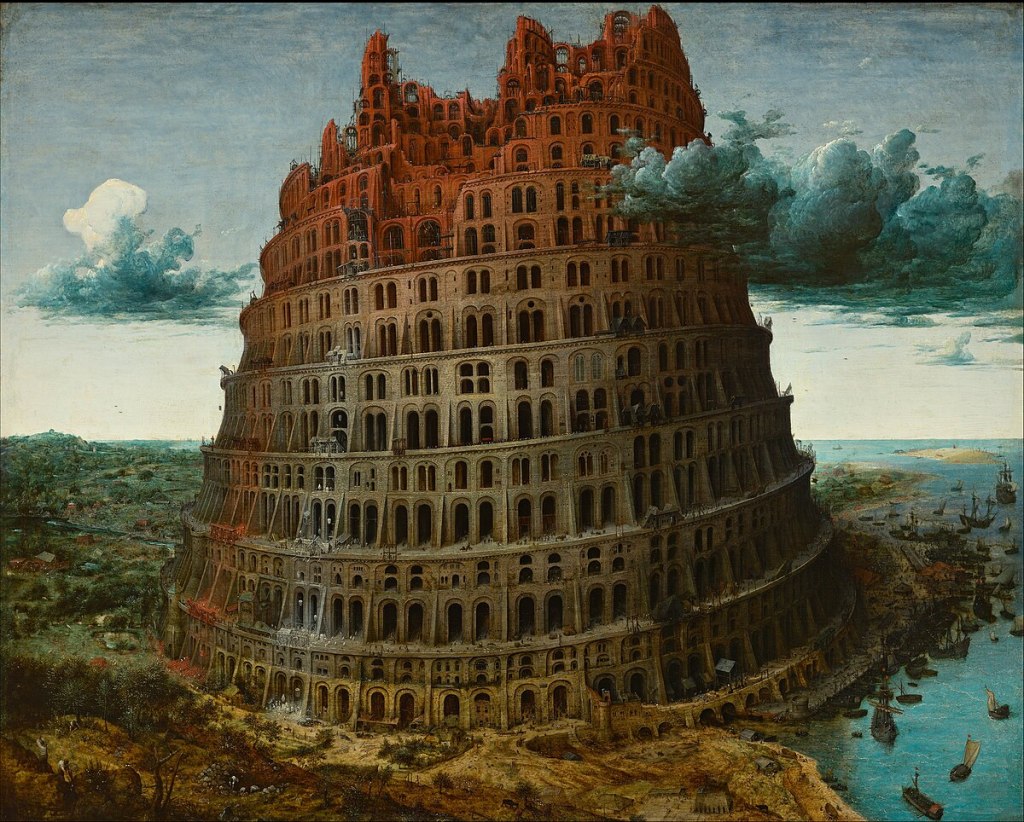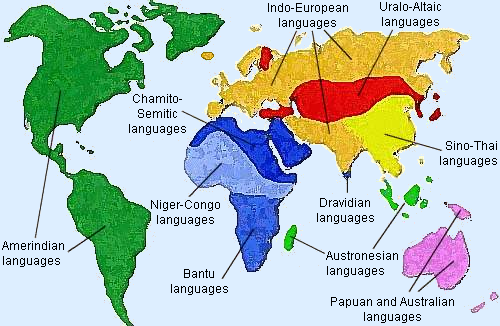
Federico Fellini once declared, “A different language is a different vision of life.” In the world today there are over 7,100 spoken languages. All of these reflect important cultural differences. Yet, languages also reveal deep historic and even regional connections. Of all of these languages, around 99% of these have their origin in 14 language families. A language family is where the word structures show a common origin. For example, the historical relationship between Spanish and Portuguese is easy to detect since 90% of their words are similar.
| Spanish (English) | Portuguese |
| Agua (water) | Água |
| Sol (sun) | Sol |
| Casa (house) | Casa |
| Día (day) | Dia |
| Mes (month) | Mês |
Languages as seemingly diverse as Russian, Spanish, Greek, and English are all derived from a common source known as the Indo-European language family, which comprises around 450 languages. The evident connection between words is clear. Another example is the Sino-Thai language family, consisting of about 500 languages. These include Mandarin (spoken in China), Tibetic (Tibet), Karenic (spoken in Burma and Myamar), Ket (spoken in Siberia). Indo-European and Sino-Thai are among ten major and very distinct language families.
Though much has been discovered about language development and families, at its root it remains unyieldingly mysterious in two ways: First, it is a mystery that humans are the only species with the capacity for language. Second, the origin of language families (e.g., Indo-European) defies evolutionary models of explanation. In this article we will examine how the evolutionary model has considerable trouble explaining these mysterious components, and we will see that the evidence for the origin of languages is consistent with the ancient biblical story of the Tower of Babel.
Challenges of Evolutionary Model
No discernible common ancestry.
To gain a clearer understanding on the family of languages, below is a distribution map of ten major language families. Remember that a language family is where the word structures show a common origin.

These are the top ten of nearly seventy language families. All of the nearly 7,100 languages can be traced back to these seventy families. Yet, these different language families cannot be traced back any further in their origin or development. The word constructions of these fourteen families do not show a common linkage. By all appearances, they developed independently from each other. This presents a significant obstacle to the evolutionary idea that language evolved from one common root.
The Evolutionary Problem
Language has no equivalent in any nonhuman species. There is no logical way to trace what has been called “grunts to grammar,” from animal expressions to the ability to have meaningful conversations or writing novels. As linguist (one who studies language) Noam Chomsky admits, “The relatively sudden origin of language poses difficulties that may be called ‘Darwin’s problem.’” The historical record shows no picture of language proceeding from a simple form to complex. Language appears to have emerged all at once as a complete package which has went from complex to increasingly simple. Rather than evolution there is devolution. Attic (classical) Greek devolved into the simplified Koine Greek and today’s much easier modern Greek. Classical Latin devolved into the romance languages like French, Italian and Spanish.
In addition to this, anthropologist (one who studies human behavior) Chris Knight highlights the sociological problem of the evolutionary model. He explains that “language simply cannot evolve in a Darwinian world—that is, in a world based ultimately on competition and conflict.” For language to evolve, it would require unusually high levels of cooperation and trust because it is socially developed and learned. The world of naturalistic evolution which paints a brutal world of tooth and claw struggle, in which the strongest survive, could not foster the needed social compatibility for language to emerge. For this reason he concludes that “language exists, but for reasons which no currently accepted [theories] can explain.”
Compatibility to the Genesis Account
So, could the origins of the language families have sprung up from a divine act, like that described in the story of the Tower of Babel (Genesis 11:1-9)? Given the lack of explanatory power of the evolutionary model, one would be left with no other choice but to consider a supernatural origin. Let’s conclude by looking at several lines of evidence which should cause us not to dismiss the Genesis story. So, let’s look at the story and then several lines of evidence which support the accuracy of the story.
1Now the whole world had one language and a common speech. 2 As people moved eastward, they found a plain in Shinar and settled there. 3 They said to each other, “Come, let’s make bricks and bake them thoroughly.” They used brick instead of stone, and tar for mortar. 4 Then they said, “Come, let us build ourselves a city, with a tower that reaches to the heavens, so that we may make a name for ourselves; otherwise we will be scattered over the face of the whole earth.” 5 But the Lord came down to see the city and the tower the people were building. 6 The Lord said, “If as one people speaking the same language they have begun to do this, then nothing they plan to do will be impossible for them. 7 Come, let us go down and confuse their language so they will not understand each other.” 8 So the Lord scattered them from there over all the earth, and they stopped building the city. 9 That is why it was called Babel—because there the Lord confused the language of the whole world. From there the Lord scattered them over the face of the whole earth.
Genesis 11:1-9
Origin of Writing and Civilization
Historians agree that civilization and writing started in the area of Sumer around 3000 B.C. Shinar, as seen in Genesis 11:2, was an area within Sumer. R.H. Robins in General Linguistics: An Introductory Survey, admits that around 3000 B.C. is “as far as one can at present go by comparative and historical inference.” In other words, that is the oldest date in which the evidence takes us. The 3,000 years BC and the Sumer (Shinar) location are significant because they are generally consistent with the biblical account.
Historical Corroboration
Abydenus (a Greek historian of the mid-fourth century B.C.), as quoted by Eusebius, spoke of a great tower at Babylon which was destroyed. The record states,
[U]ntil this time all men had used the same speech, but now there was sent upon them a confusion of many and divers tongues.
Josephus, the Jewish historian, quoting from an ancient source, records these words:
When all men were of one language, some of them built a tower, as if they would thereby ascend up to heaven, but the gods sent storms of wind and overthrew the tower, and gave every one his peculiar language; and for this reason it was that the city was called Babylon.
Antiquities of the Jews, 1.4.3
Authenticity Of Genesis 11
The details of Genesis 11 show striking accuracy from a historical perspective. Consider the following:
- Genesis 11:2 describes the land of Shinar as one of the cradles of ancient civilization, which corresponds to modern scholarship on the influence of Sumer on the ancient Near East.
- The identification of Babylonia with Shinar was apparently known in the earliest of times (compare Genesis 10:10, Daniel 1:2).
- The description of a tower is combatable with the fact that such towers were called ziggurats. These towers consisted of several platforms which were constructed one on top of the other platforms. These became progressively smaller in size till a pinnacle was reached which accommodated a small temple dedicated to a particular deity.
- The reference to “brick” and “tar” (11:3-4) has a genuine touch of authenticity. The region of Babylon did not contain the common building stone that was characteristic of Palestine, where most of the biblical accounts were written. These fired bricks from that area were usable for centuries showing the author of this story had a correct understanding to the region where the events took place.
For these reasons and others, Donald J. Wiseman, professor of Assyriology at the University of London, has confidently stated that the record in Genesis 11 “bears all the marks of a reliable historical account.”
Other Traditions Around the World
Stories about a tower and sudden language changes appear in ancient histories from Sumerian, Grecian, Polynesian, Mexican, and Native American sources. This is what we might expect if the Tower of Babel was a real event. There would be people spreading throughout the world from Shinar carrying the tradition of the account. Stories of language changes, ziggurats, towers, names of Noah are confirmations of the events at Babel.
Conclusion
The topic of language is complex. What is clear, though, is that language is a gift. Each tongue expresses something beautiful about each tribe, country and culture which speaks it.
“Language is the road map of a culture. It tells you where its people come from and where they are going.”
Rita Brown
The story of the Tower of Babel affirms God’s love of diversity as seen in the different languages. The apostle John’s revelation of the end of the ages magnificently reinforces this.
After this I looked, and there before me was a great multitude that no one could count, from every nation, tribe, people and language, standing before the throne and before the Lamb.
Revelation 7:9